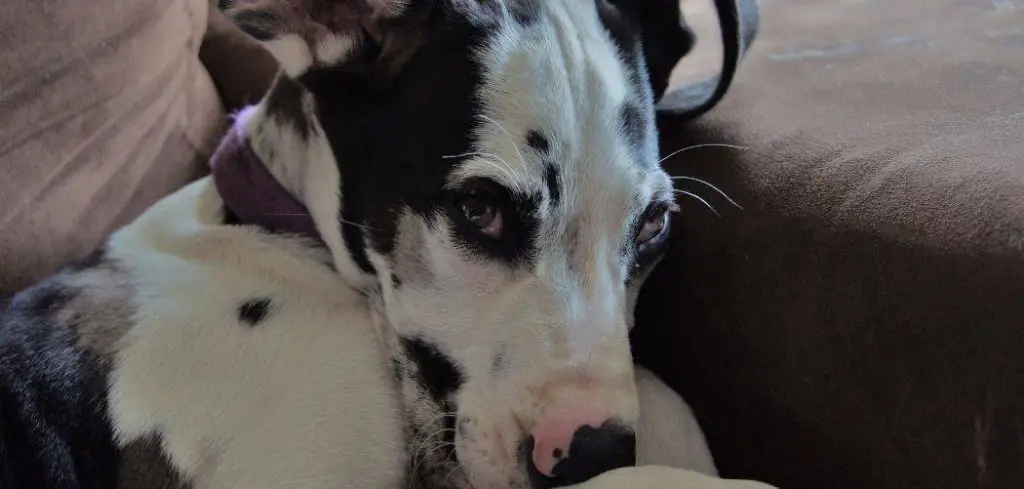Seeing your dog throw up bile and food can be alarming. Vomiting that includes partially digested food along with yellow or greenish bile often points to irritation in the stomach or intestines or more serious health problems.
We outline the common causes of dogs throwing up bile and food, what you can do at home, and when to seek veterinary help.
Dog Throwing Up Bile and Food — Why It Happens
Dogs often vomit bile and food because their digestive system is irritated or inflamed. This may happen if they eat too quickly, develop gastritis, suffer from acid reflux, or have an underlying illness such as pancreatitis or intestinal obstruction.
Bile, which is a digestive fluid produced by the liver and stored in the gallbladder, mixes with food in the stomach and intestines. When vomiting occurs, both partially digested food and bile can be expelled.
While occasional vomiting may be minor, repeated or severe episodes can signal more serious problems.

Dog Throwing Up Bile and Food: Common Causes
Gastritis (Stomach Inflammation)
Gastritis occurs when the stomach lining becomes irritated, often from eating spoiled food, garbage, or something foreign.
This irritation can cause your dog to vomit both bile and undigested food. You may notice other symptoms such as drooling, abdominal pain, or refusal to eat.
While mild gastritis can sometimes pass with rest, recurring cases can dehydrate your dog and require medical care.
Read more: Dog Throwing Up Bile and Diarrhea (What it means for your pup)
Eating Too Quickly
Some dogs wolf down their meals so fast that their stomach struggles to cope. This can lead to regurgitation or vomiting soon after eating, often mixed with bile.
Large breeds are particularly prone to gulping food, which can also put them at risk for bloating.
Using slow-feeder bowls or smaller, more frequent meals can help prevent this type of vomiting.
Acid Reflux
Just like humans, dogs can suffer from acid reflux, where stomach acid backs up into the esophagus.
When this happens, your dog may vomit bile along with partially digested food.
Acid reflux often occurs if your dog has gone too long without eating, or after eating fatty or spicy foods. It can cause discomfort, coughing, or even signs of pain when swallowing.
Pancreatitis
Pancreatitis is a painful and serious condition where the pancreas becomes inflamed, often triggered by eating fatty foods.
Vomiting is one of the hallmark symptoms, and it can include both bile and food. Other signs include lethargy, abdominal pain, diarrhea, and loss of appetite.
Pancreatitis can be life-threatening if untreated, so prompt veterinary care is essential.
Intestinal Blockage
If your dog has swallowed a toy, bone, or other non-food item, it may become lodged in the digestive tract.
This obstruction prevents food from moving normally, leading to repeated vomiting of bile and food.
Dogs with a blockage often refuse to eat, appear lethargic, and may cry out in pain. Intestinal blockages are emergencies and require immediate veterinary attention.
Infections and Parasites
Bacterial or viral infections, such as parvovirus, or intestinal parasites like roundworms can also cause vomiting that includes bile and food.
These illnesses often come with diarrhea, weakness, and dehydration. Puppies and unvaccinated dogs are at higher risk and can deteriorate quickly without treatment.
Read more: Dog Throwing Up Bile and Grass (Causes and what to do)
What to Do If Your Dog Is Throwing Up Bile and Food
If your dog vomits once but seems otherwise normal, you may monitor them closely and temporarily withhold food for a few hours to let their stomach settle. Afterward, offer small amounts of bland food, like boiled chicken and rice, to see if they can keep it down.
Make sure your dog stays hydrated, since vomiting can quickly lead to fluid loss. Offer fresh water in small amounts, or ice cubes if they won’t drink right away. Avoid giving treats or fatty foods during recovery.
If your dog tends to eat too fast, try switching to smaller, more frequent meals or using a slow-feeder bowl. This can reduce strain on their stomach and prevent regurgitation.
Keep an eye on your dog’s behavior, appetite, and energy. If vomiting continues or other concerning symptoms appear, it’s safest to call your vet.
When to Call or Visit Your Vet
Seek immediate veterinary care if your dog:
Vomits repeatedly within a short time.
Throws up bile and food consistently for more than 24 hours.
Shows signs of severe abdominal pain, bloating, or distress.
Has diarrhea, blood in vomit, or black/tarry stools.
Refuses food and water completely.
Becomes lethargic or unusually weak.
These signs may indicate pancreatitis, intestinal blockage, or another serious condition that requires urgent treatment.
Read more: Dog Throwing Up Bile and Pooping Blood (Here’s why it happens)
Key Takeaway
A dog throwing up bile and food can be unsettling, but understanding the possible causes helps you respond appropriately. While occasional vomiting may be a simple digestive upset, repeated or severe cases can point to serious health problems.
Watch for warning signs, provide gentle at-home care when appropriate, and don’t hesitate to call your veterinarian if you’re concerned.
Acting quickly can make all the difference in keeping your dog safe and healthy.
